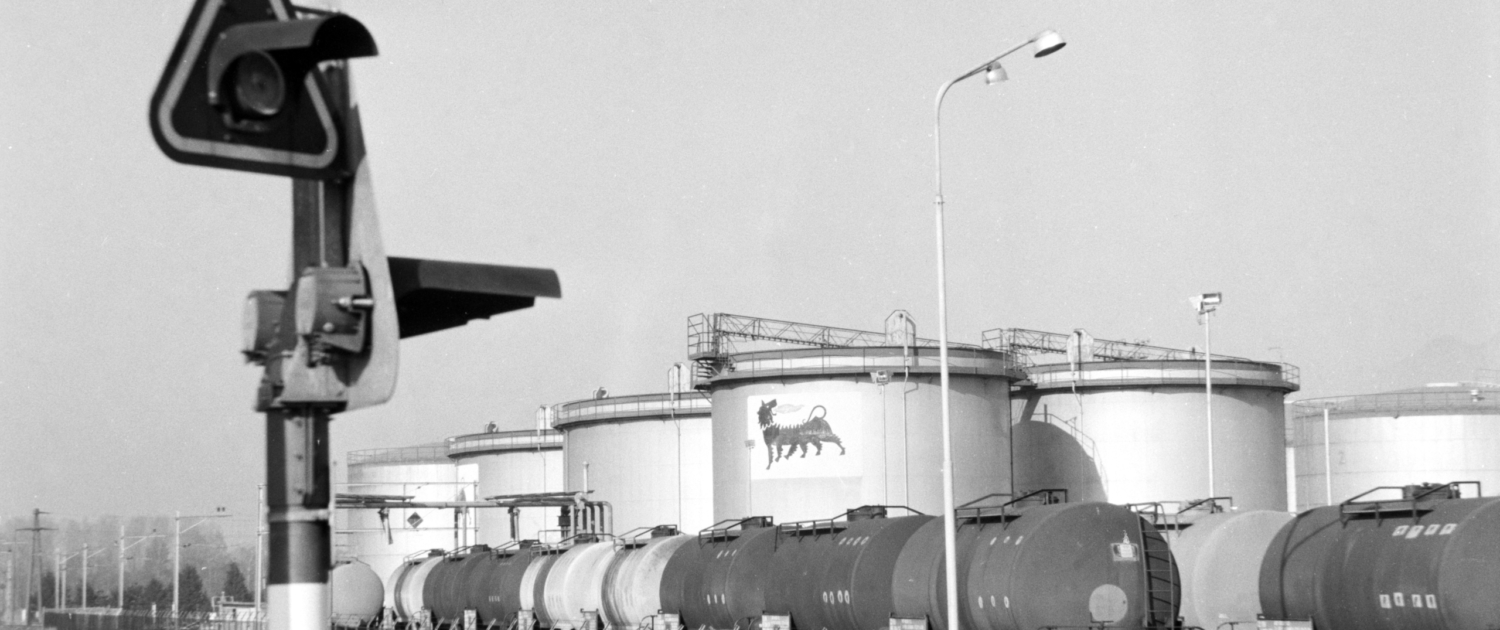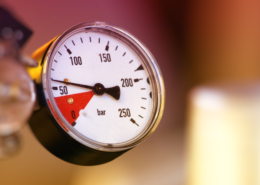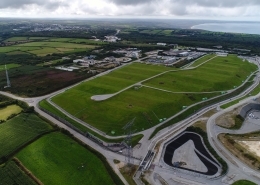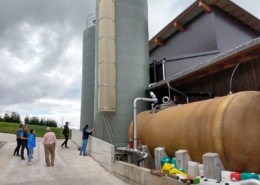Coal, oil, gas: four highlights on the history of fossil energies in Switzerland
Since the middle of the 19th century, Switzerland's energy supply has been based mainly on fossil fuels. Around 1850, coal became the central energy source of the industrial society. After the Second World War, coal was then replaced by oil. The economic growth of the post-war period was associated with a rapid increase in energy consumption. Cheap oil brought us prosperity, but also led to the waste of resources and energy and caused increasing ecological problems. The following four highlights take a look at the history of fossil energies in Switzerland.
1918: People had to freeze, eat cold and walk in winter
In Switzerland, the exponential increase in coal consumption began in 1850 with the expansion of the railway. The railway enabled the import of large quantities of coal, which quickly became the basis for industrial growth. The metal and machine industry, the chemical industry and the food industry were all dependent on coal. The First World War was the first time that Switzerland became drastically aware of its dangerous dependence on fossil fuels.
During the war, coal supplies were used primarily by Germany as a means of exerting political pressure on Switzerland. At the time, 90 percent of the coal came from Germany, with the remaining 10 percent coming from France. From 1916 onwards, coal deliveries from Germany gradually decreased and the calorific value of the coal supplied declined more and more. In 1918 and 1919 the energy crisis reached its peak. For the population, the forced reduction in energy consumption meant massive restrictions: people had to freeze in winter, eat cold food and walk.
The rationing of coal led to savings in heating and cooking and to restrictions in mobility. There were fewer passenger trains and no express trains at all. Because of the shortage of oil, the Federal Council also considered banning motor traffic. The rural population had to give up their kerosene lamps and light their houses with candles again.
The supply shortage caused by the lack of coal and oil imports meant that Switzerland lost its economic sovereignty. At the same time, the energy crisis during the First World War helped electricity from domestic hydroelectric power to make a breakthrough. After the war, the nationwide electrification of the railway network began. In addition, "fuel offices" were introduced for the first time during the First World War and the first compulsory stocks of fuel were created after the war.
1945: Supply bottlenecks led to rigorous austerity measures
In order to prepare for future supply crises, the Swiss Central Office for the Importation of Liquid Fuels and Combustibles(CARBURA) was created in 1932. When another shortage situation became apparent on the eve of the Second World War, the Federal Council decreed a car-free Sunday for the first time in 1936. In 1937, compulsory stocks of fossil fuels were enshrined in law.
Nevertheless, Switzerland was ill-prepared for war. The economic stocks of petrol, diesel and heating oil were sufficient for a good three months, but the army's stockpiling was extremely precarious. Therefore the economic stocks had to be confiscated, otherwise the army would have been incapable of acting. As oil imports dried up, a dramatic shortage of fuel set in. The supply bottlenecks forced rigorous austerity measures.
From 1940, a general ban on driving on Sundays came into force, and from 1941, motor vehicles were taken out of service en masse. Trucks were converted to wood carburetors and private individuals hardly received any gasoline. As there was a shortage of heating oil, the population increasingly used electricity for heating. In 1942, however, due to the lack of electricity, electric space heating in general and the electric production of hot water during the week had to be banned. Some households could no longer heat at all.
Therefore, public warming rooms were set up to save small children and old people from freezing to death. Coal was again increasingly used as fuel for heating households, but supplies from Nazi Germany were regularly used in winter to extort economic concessions from Switzerland. The rationing of petrol, kerosene and heating oil was not completely lifted again in Switzerland until 1946.
1960: After the war, a veritable petroleum rush set in
While the Second World War was marked by scarcity, the war was followed by abundance and waste. Europe and the USA went into a veritable petroleum frenzy. From 1950 to 1973, unprecedented global economic growth set in. The consumption of petrol, diesel, kerosene and heating oil as well as the sale of plastics increased enormously worldwide.
The car and central heating became symbols of consumer society. In the early 1950s, mass motorization began in Switzerland. The car became a status symbol. The road network was massively expanded and motorways ploughed through the countryside. Roads, motorways, car parks, garages, petrol stations, shopping centres and service stations were built all over the country.
In the 1950s, the international oil companies Shell, Esso and BP were also interested in drilling for oil in Switzerland. Switzerland was considered a politically stable country where revolutions, wars and nationalizations were almost completely out of the question. The cantons, which were able to award the oil concessions, sensed a good deal and were already dreaming of big money.
However, the interest of the oil companies also aroused fears in neutral Switzerland of a sell-out of the homeland. The Federal Council feared the imperial desires of other states during the Cold War. After the coup in Iran in 1953, the awarding of oil concessions to foreign companies was seen as a threat to Switzerland's national security, independence and neutrality.
In 1956, the Suez crisis once again made Switzerland aware of its dependence on fossil imports. As a result, Swisspetrol AG was founded in 1959 to explore for oil and gas in Switzerland. The cantons now only sold their oil concessions to Swisspetrol AG. Between 1958 and 1966, a total of 17 wells were drilled, but all were unsuccessful and failed to uncover any commercially exploitable deposits.
1973: Due to the oil crisis, the Federal Council decreed three car-free Sundays
In 1973, oil already accounted for almost 80 percent of Switzerland's total energy requirements. The shock was all the greater when the oil crisis occurred in October 1973. After the outbreak of the Yom Kippur War, the most important Arab states unceremoniously turned off the oil tap in order to punish the Western industrialized countries for their pro-Israeli policies. In the US and Europe, fears of an oil shortage spread.
In view of the looming shortage, the Federal Council called on the population to be frugal. On 21 November 1973, the Federal Council decreed three car-free Sundays and imposed a speed limit of 100 km/h on the motorways. The 1973 oil crisis brought the post-war economic miracle to an abrupt end. The idea of inexhaustible resources was irretrievably gone. The new environmental movement now criticised Western consumer society, its insatiable hunger for energy, the unrestrained waste of raw materials and the associated environmental destruction.
In 1974, under the impact of the oil crisis, the Federal Council set up the Swiss Federal Energy Commission (GEK), which for the first time was to draw up a long-term strategy for Switzerland's energy supply. The energy article for the Federal Constitution was subsequently drafted on this basis. The "magic word" of energy policy at that time was "diversification": in order to reduce the one-sided dependence on oil, greater reliance was to be placed on natural gas, nuclear energy and renewable energies.
However, the intention to save energy and diversify supply was not very sustainable. In the 1980s and 1990s, oil was once again so cheap that concerns about security of supply quickly dissipated. At that time, the global oil rush continued unabated in Switzerland as well.
After the 1973 oil crisis, natural gas was also marketed as an environmentally friendly alternative to oil. Its share of the energy supply in Switzerland grew from 2.2 to 13.5 percent between 1974 and 2013. It was used to heat buildings, as process heat in industry and commerce, and to produce electricity.
Michael Fischer, historian and specialist in Federal Council and parliamentary affairs at the Swiss Federal Office of Energy
Further literature
Ganser, Daniele: Europe in the oil rush. The consequences of a dangerous dependence. 4. Ed. Zurich: Orell Füssli, 2014.
Gisler, Monika: Die Schweizerische Gasindustrie 1850-2020. Zurich: Verband der Schweizerischen Gasindustrie VSG, 2020.
Gisler, Monika: "Swiss Gang. Pioneers of oil exploration. Zurich: Verein für wirtschaftshistorische Studien, 2014a.
Gisler, Monika: Petroleum in Switzerland. A brief cultural history. Zurich: Verein für Wirtschaftshistorische Studien, 2011.
Kupper, Patrick; Pallua, Irene: Energieregime in der Schweiz seit 1800. Swiss Federal Office of Energy SFOE, Energy-Economy-Society (EWG) research programme, 11.07.2016.
Marek, Daniel: Coal. Die Industrialisierung der Schweiz aus der Energieperspektive 1850-1900. Dissertation, University of Bern, 1992.
Pfister, Christian: Freezing, eating cold and walking. The energy crisis 1917-1919 in Switzerland. In: Krämer, Daniel; Ders.; Segesser, Marc (eds.): "Woche für Woche neue Preisaufschläge". Food, energy and resource conflicts in Switzerland during the First World War. Basel: Schwabe Verlag, 2016, pp. 113-132.
Pfister, Christian: The "1950 syndrome": the environmental-historical epochal threshold between industrial society and consumer society. In: Ders. (ed.): The 1950s Syndrome. The road to consumer society. Bern, Wien u.a.: Haupt, 1995, pp. 51-95.
 Keystone
Keystone
 3 Vote(s), Durchschnitt: 4,67
3 Vote(s), Durchschnitt: 4,67 ShutterstockAktivkohle & Co effizient nutzen
ShutterstockAktivkohle & Co effizient nutzen  Geheimnis um Gebäudetechnikpotenziale gelüftet
Geheimnis um Gebäudetechnikpotenziale gelüftet  ©Biplan / AndraGeologische Tiefenlager: Was wirklich wichtig ist
©Biplan / AndraGeologische Tiefenlager: Was wirklich wichtig ist  Benedikt VogelIdeen für mehr Biogas
Benedikt VogelIdeen für mehr Biogas 
 Tiefbauamt Baudirektion Kanton Zürich
Tiefbauamt Baudirektion Kanton Zürich zvg - Armin Meier
zvg - Armin Meier
Dein Kommentar
An Diskussion beteiligen?Hinterlassen Sie uns Ihren Kommentar!